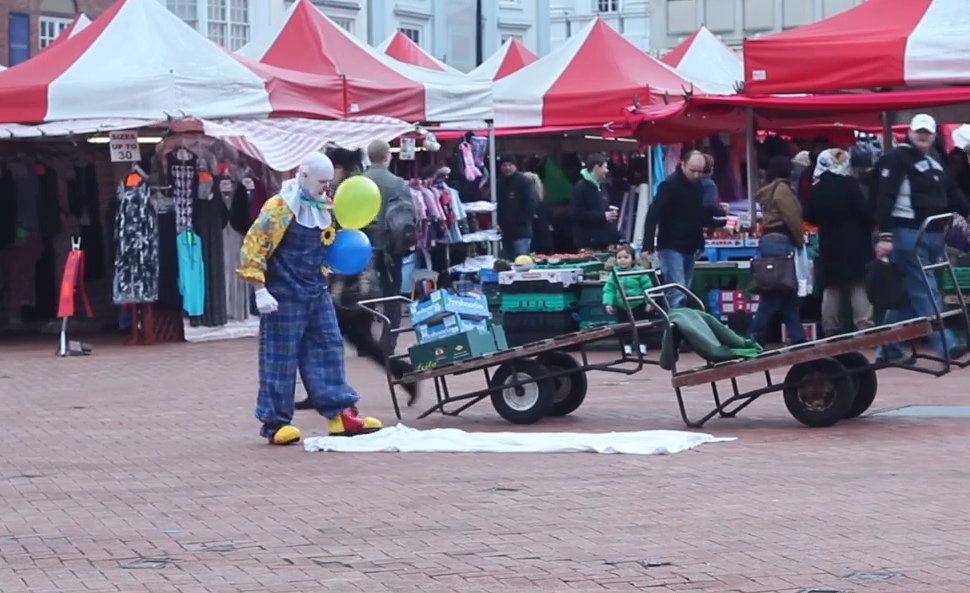
Scary Clown Terrorizes British Town

A mysterious and sinister clown has been sighted prowling the streets of Northampton, U.K., causing both curiosity and concern. Nocturnal sightings of the face-painted fiend — widely dubbed The Northampton Clown — began earlier this month. The clown has not harassed, attacked, nor threatened anyone; he — or possibly she or It — merely wanders the streets creeping people out (and sometimes poses for photos).
A Facebook page was set up last week (on Friday the 13th, appropriately enough) called "Spot Northampton's Clown," featuring photos of the clown at different locations throughout the city. Someone claiming to be the clown has posted photos, updates and notes saying he's harmless and just having a bit of fun.
If it all seems like a viral prank, publicity stunt or theatrical melodrama, it may be. In fact, a second man, dressed in his own blue muscle-padded superhero costume and glasses, calling himself "Boris the Clown Catcher," has appeared on the Northampton streets on a mission to capture the creepy clown. Some have suggested that Boris is himself the Northampton Clown, adopting the role of both hero and villain in a social media prank. [Really? The 6 Most Outrageous Hoaxes]
Boston's mystery clown panic
Strange as this case is, it's not the first time that concern over clowns has gripped a city. In May 1981, police in Brookline, Mass., issued an all-points bulletin (APB) asking officers to watch for a vehicle containing potential child abductors. The vehicle, an older model van with a broken headlight and no hubcaps, was reportedly occupied by several clowns in full costume. Several children reported that clowns had tried to lure them into the van with promises of candy.
It was only one of several mysterious sightings of the phantom clowns; the next day, Boston police again searched the city in vain for another van driven by a creepy clown reported to be stalking a public park; once again police searches came up empty. As reports spread to surrounding areas and parents grew nervous, an official from the Boston Public Schools issued a memo to principals in his school district: "It has been brought to the attention of the police department and the district office that adults dressed as clowns have been bothering children to and from school. Please advise all students that they must stay away from strangers, especially those dressed as clowns."
Parents were fearful, children were warned and police were vigilant, but despite searches and police checkpoints, these mysterious clowns were never found. Whether these creepy clowns were real, or the product of mass hysteria, pranks, eyewitness mistakes, the power of suggestion and the media, or some mix of these, no evidence was ever found of their existence.
Sign up for the Live Science daily newsletter now
Get the world’s most fascinating discoveries delivered straight to your inbox.
The Northampton Clown, on the other hand, seems real enough. Though the clown has undoubtedly made some people genuinely uneasy, it seems that most are discussing this phenomenon with their tongues firmly planted in their cheeks.
The fact that the clown poses for photographers suggests an element of hoaxing or mischief; after all, if anyone thought the clown was a serious threat they could follow him or call the police. It's also important to note that England has, by some estimates, nearly 2 million surveillance cameras in operation. Public streets are routinely monitored and recorded, and it would be a simple matter for police to review footage to locate a doorway or vehicle where the clown emerged. That is, of course, assuming that they believed there is any threat; walking around dressed as a clown at night is not illegal.
Creepy clowns
Fear of clowns — called coulrophobia — is fairly common, especially in young children. The reasons people find clowns scary vary from person to person; sometimes, the fear stems from a childhood trauma with a specific clown, other times, it's just a general unease with all clowns. [What Really Scares People: Top 10 Phobias]
But there are a few reasons why clowns are often considered creepy and disturbing. Clowns exaggerate for effect, distorting reality and proportion. They drive impossibly tiny cars and carry outsized gear, such as tricycles the size of elephants and hammers the size of logs. Nearly everything about a clown, including his or her speech, actions and clothes, are either too big or too small, and nothing about them is normal.
Clowns are at once both instantly recognizable and yet totally anonymous. We don't know who is behind that makeup and red rubber nose: a kindly grandfather or a serial killer? And, of course, clowns are also unnatural in another way: No normal person could willingly put up with hordes of children screaming and jumping all over them for that long.
While the Northampton Clown seems to be having harmless fun (for example, today, Sept. 17, promising on Facebook a big surprise for later this week), the real danger is probably the threat of copycats hijacking the phenomenon and getting in on the act; already there are a few reports of (apparently independent) clowns pretending to be the Northampton Clown.
Or are they? The mystery continues.
Benjamin Radford is deputy editor of "Skeptical Inquirer" science magazine and author of six books including "The Martians Have Landed! A History of Media-Driven Panics and Hoaxes." His website is www.BenjaminRadford.com.
Follow LiveScience @livescience, Facebook & Google+. Original article on LiveScience.










